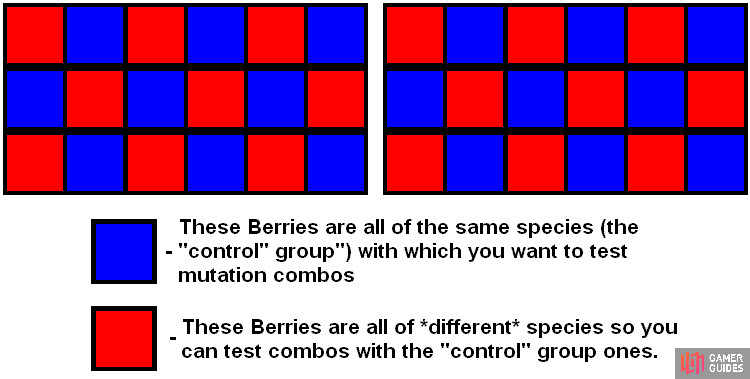The Berry Fields are south of the Route 6 and Route 7 branch.
People who’ve played the GBA and DS Pokémon games (Black/White excluded) probably recall an interesting little quest about growing Berries… Okay, fine, it wasn’t even remotely interesting, and easy enough to skip since it had little gameplay impact.
While the Berries still have little true hold here, stuff like the Lumiose Juice Shoppe make growing and harvesting Berries all the more valuable. Add that in with the additional aspects added in with it and you’ll have yourself something to at least think about doing.
The Berry Fields are only found in one place, off of Route 7 to the south. There, you’ll be told about the Berry fields and stuff. There are 36 plots of loamy soil here for you to grow Berry trees on. The Berries grown must come from you in some way - from berry trees, as gifts or, of course, by growing them yourself!
Berry growth begins with planting. To plant a Berry, simply examine one of the empty lumps of dirt and select a Berry to plant. You should water it with the Sprinklotad you’re given, as plants need water for photosynthesis. From there, for the most part, you have to do almost no work if you don’t want to.
Plant, water, then wait… and profit!
However, if you want to harvest better crops - and you will want to - you need to consider some other things. (For the record, bad crops usually hold 0 to 3 Berries, whereas well-managed ones have yielded 10 ~ 15 for me per Berry planted.)
Plants get weeds around them. It’s a known fact, and weeds suck up nutrients. While there’s no major consequence to this, it does make the harvests less plentiful and you’ll get fewer Berries. Simply examine them and pull up the weeds to get rid of the nuisance. Problem solved with high maintenance, if you deem it needed.
Bugs also are a problem. While you won’t have vast swarms of locusts or cicadas coming around (awww…), you will have a few species of Bug-typed Pokémon to deal with. You’ll basically have to battle them for your plants back.
Finally, fertilizer . We’ll be getting our mulch from the same source as our plants: in the northwest and southeast corners of the Berry farm, you will find composters into which you can fit three Berries to make mulch in. Mulch can help plants grow, among … other things…
Mulch¶
Perhaps we should discuss mulch in better detail? As you probably know, mulch can be made in the composters in the northwest and southeast corners of the field: toss in three Berries and you’ll get three units of some type of mulch. If you spread it around the Berry plots, you can get a number of changes.
| Mulch | Berry Combinations | Effects of Mulch |
|---|---|---|
| Boost Mulch | Two same-colored Berries + one different-colored one | Lessens the amount of watering needed |
| Rich Mulch | Three Berries of different colors | Lessens the amount of general care needed |
| Surprise Mulch | Three Berries of the same color | Increases the chance of Berry mutations… |
For the record, if you’re having trouble discerning Berry color (red, blue, yellow, green, pink, and purple being the ones the game considers), you can just use Berries of the same species in the case of the Boost/Surprise Mulch - for example, three Oran Berries still yields Surprise Mulch.
If you plan to do this, though, we recommend devoting two or three other plots for that same Berry each time, so you can continue to have plenty.
Mutations¶
Some of these berries can also be gotten from the Pokemon Global Link site.
Hopefully by now, most of you are familiar with the reproductive aspects of hybridization and cross-pollination. If not, the brief lesson is this. If you plant two plants of different appearances - or even species - next to each other, they may pollinate and produce a plant.
This child plant can be one of a whole new species, or have intermediate characteristics of the parents, or use the dominant genotypes in their DNA. Whatever the case, the odds that they’ll be the same is highly unlikely.
In Berries, a similar concept takes place. When you plant two Berries of different species next to each other, you may find additional Berries species among each tree’s harvest. It’s simple enough to understand, and is further aided by the Surprise Mulch.
After getting mutation and trying to leave the area, a Scientist will come and take residence in the northeastern house. She can give you the mutation combos you’ve discovered, helpful if you forgot them or aren’t sure how they came about.
Anyways, let’s firstly assume you want to optimize this normally trial-and-error process. Well, in that case, you need to fill in every other plot with a Berry of the same species: that means 18 Oran Berries, 18 Leppa Berries, or whatever. The remaining should be filled with differing species of Berries.
So, for the known combos? Here are some below. As a note, there are 67 species of Berries as of Generation VI - in theory, that means up to 4,422 possible mutations. Of course, there still would be 67 species, so we’re saying like each Berry could have on average 66 mutation combos.
If you’ve forgotten the Berry mutations you have found, again, a Scientist that appears in the northeastern house can help.
| Berry Mutation | Parent 1 | Parent 2 |
|---|---|---|
| Apicot Berry | Kelpsy Berry | Wacan Berry |
| Ganlon Berry | Qualot Berry | Tanga Berry |
| Grepa Berry | Aguav Berry | Figy Berry |
| Hondew Berry | Aspear Berry | Leppa Berry |
| Kee Berry | Ganlon Berry | Liechi Berry |
| Kelpsy Berry | Chesto Berry | Persim Berry |
| Liechi Berry | Hondew Berry | Yache Berry |
| Maranga Berry | Apicot Berry | Petaya Berry |
| Petaya Berry | Kasib Berry | Pomeg Berry |
| Pomeg Berry | Iapapa Berry | Mago Berry |
| Qualot Berry | Oran Berry | Pecha Berry |
| Salac Berry | Grepa Berry | Roseli Berry |
| Tamato Berry | Lum Berry | Sitrus Berry |
Bug Pokemon Finds¶
This section is mostly used just to describe that there are a number of Bug Pokémon you can find when growing Berries - they will be on shaking trees, simply examine them to find ’em. None of them are particularly noteworthy for actual use in the game, beyond Pokédex completion. (And, of course, that only female  Combees evolve. And all Combees hold Honey.)
Combees evolve. And all Combees hold Honey.)










 Sign up
Sign up
No Comments